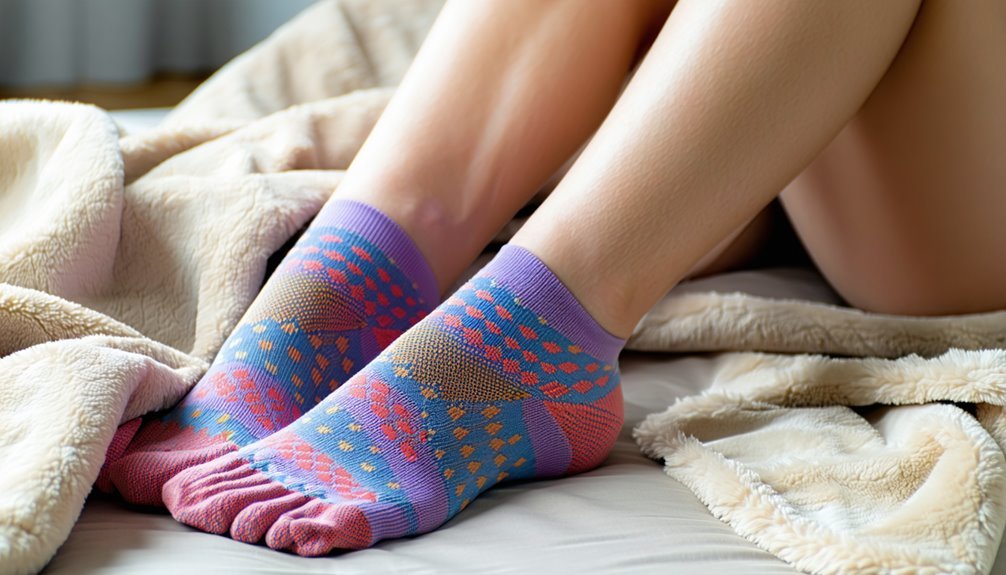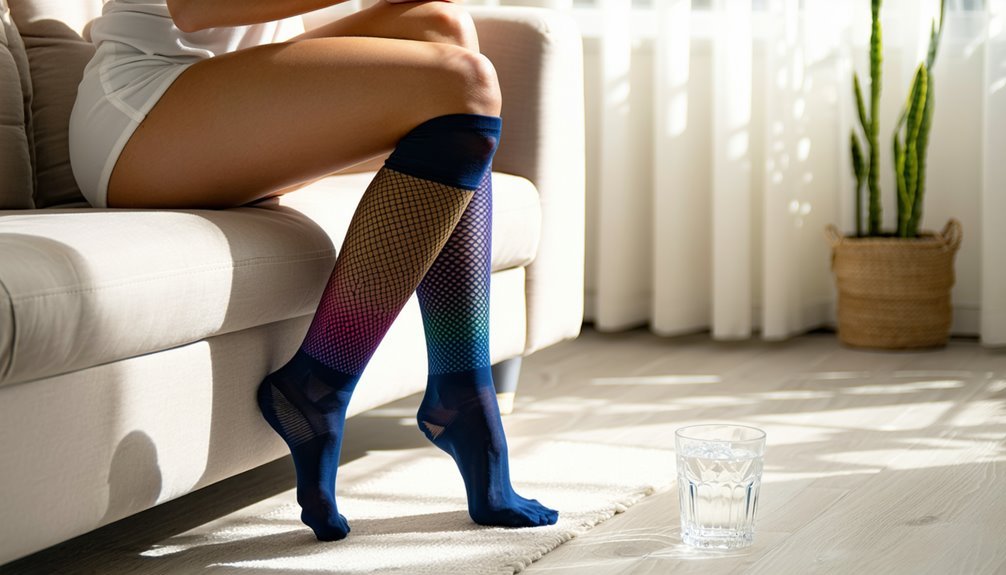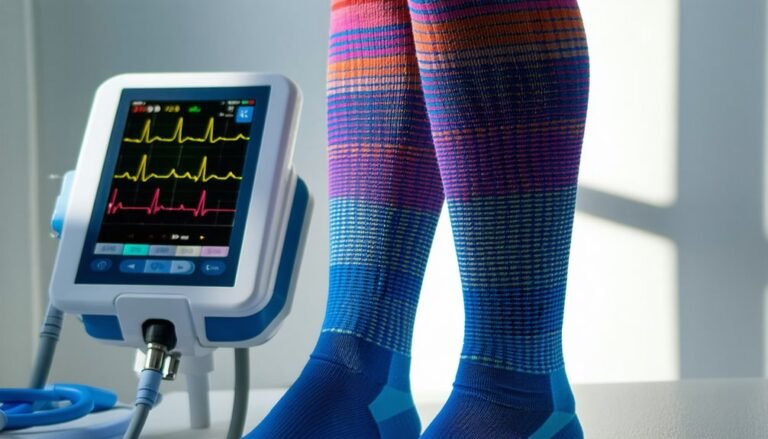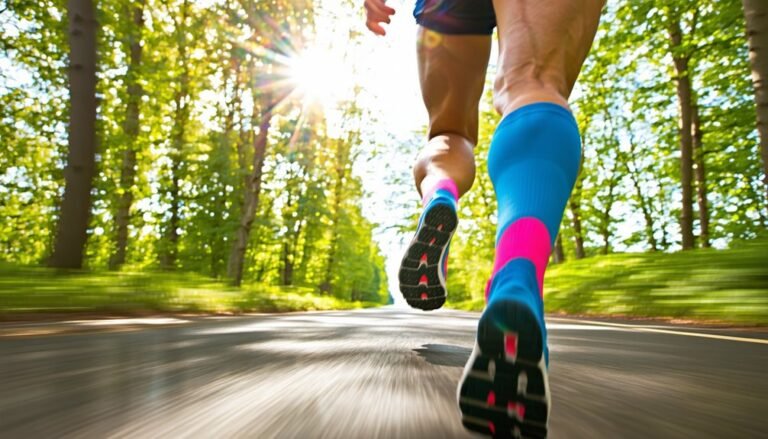Can Compression Socks Help With Leg Cramps?
Compression socks can effectively alleviate leg cramps by promoting better blood circulation and providing essential muscle support. They apply gentle pressure, enhancing blood flow and helping to prevent cramping caused by poor circulation. Recent studies support their use, showing a marked reduction in cramp severity and frequency for many individuals. Consulting a healthcare provider guarantees the compression type and fit best suit your needs, and with continued exploration, you'll uncover more about their benefits.
Understanding Leg Cramps: Causes and Symptoms

When it comes to understanding leg cramps, recognizing the underlying causes and symptoms is essential for effective management. Leg cramps, often described as sudden, involuntary muscle spasms, can disrupt your daily life and sleep. These spasms typically occur in the calf muscles and can last from a few seconds to several minutes. Causes include muscle fatigue, dehydration, and electrolyte imbalances. It's vital to listen to your body—if you're experiencing frequent or severe cramps, it's wise to consult a healthcare professional. They can help identify potential triggers and underlying health conditions, such as nerve compression or circulatory issues. By understanding the root causes, you can take proactive steps to prevent and manage these painful episodes, ensuring your safety and well-being.
What Are Compression Socks and How Do They Work?
Compression socks are specialized hosiery designed to improve circulation and reduce discomfort in your legs. They work by applying graduated pressure, which helps to enhance blood flow and prevent the pooling of blood in the lower extremities. Available in various types and materials, these socks can be tailored to your specific needs to effectively manage and alleviate leg cramps.
Definition and Purpose
Compression socks, often recommended by healthcare professionals, are specially designed hosiery that apply graduated pressure to your legs and feet. They play an essential role in compression therapy, promoting muscle recovery and reducing discomfort associated with leg cramps. By gently squeezing your legs, these socks help improve blood flow, which can prevent cramping and support your overall leg health.
When considering compression socks, it's important to understand their key benefits:
- Enhanced Circulation: Helps maintain proper blood flow, reducing the risk of swelling and pain.
- Muscle Support: Provides stability and aids in the recovery of tired muscles.
- Safety and Comfort: Designed for daily wear, guaranteeing comfort without compromising your safety.
Always consult with your healthcare provider to ascertain these socks are suitable for your specific needs.
Mechanism of Action
Though often overlooked, the mechanism by which compression socks alleviate leg cramps is both simple and effective. When you wear them, they apply gentle pressure to your legs, promoting improved blood flow. This enhanced circulation helps deliver oxygen and nutrients to your muscles, aiding in muscle relaxation. By reducing blood pooling in the lower extremities, compression socks decrease the risk of cramps, which can often result from poor circulation. The pressure they provide also supports the venous valves in your legs, helping blood return to the heart more efficiently. This continuous flow diminishes the likelihood of muscle fatigue and spasms. Wearing compression socks is a proactive step you can take to guarantee your leg muscles remain relaxed and cramp-free.
Types and Materials
Many individuals seeking relief from leg cramps turn to compression socks, a specialized type of hosiery designed to apply pressure to the legs. These socks come in various types, including graduated, anti-embolism, and non-medical support. Each type offers unique benefits depending on the severity and cause of your cramps.
The material of compression socks also plays a pivotal role in effectiveness and comfort. Common materials include nylon, spandex, and polyester, each providing specific benefits:
- Nylon: Offers durability and a snug fit.
- Spandex: Allows flexibility while maintaining pressure.
- Polyester: Guarantees moisture-wicking and breathability.
Selecting the right compression sock type and material benefits your comfort and safety. Always consult with a healthcare provider to ascertain the best choice for your specific needs.
The Science Behind Compression Socks and Blood Circulation
You might wonder how compression socks can alleviate leg cramps by improving blood circulation. These specialized socks apply gentle pressure to your legs, which enhances venous return, reduces muscle fatigue, and improves oxygen delivery to tissues. By understanding the science behind these benefits, you can make informed decisions about using compression socks as a preventative measure for leg cramps.
Enhanced Venous Return
Understanding the mechanism of enhanced venous return through the use of compression socks can be pivotal for those suffering from leg cramps. These socks apply gentle pressure on your legs, addressing venous insufficiency by promoting efficient blood flow. This pressure helps the veins push blood back to your heart, reducing the risk of pooling and cramps. Improved circulation can alleviate discomfort and provide a sense of security, especially for those at risk of leg cramps.
Consider these advantages:
- Improved blood flow: Compression socks enhance circulation, minimizing venous insufficiency.
- Reduced swelling: By promoting better venous return, these socks can prevent fluid buildup.
- Comfort and support: The added compression offers a snug, secure feeling, reducing the likelihood of cramps.
These benefits make compression socks a safe option for managing leg cramps.
Reduced Muscle Fatigue
Several studies highlight the role of compression socks in reducing muscle fatigue, particularly through their impact on blood circulation. By applying graduated pressure, these socks enhance venous return, promoting efficient blood flow back to the heart. This increased circulation aids in muscle recovery by flushing out metabolic waste products accumulated during physical activity. Consequently, you may experience less muscle soreness and fatigue after exercise, enhancing your overall exercise performance.
Compression socks provide consistent support to the muscles, which can minimize the micro-traumas that naturally occur during physical activity. This reduces the stress on your muscles, potentially lessening the occurrence of cramps. If you're looking to improve recovery times and maintain safety during workouts, compression socks are a practical option supported by scientific research.
Improved Oxygen Delivery
When considering the benefits of compression socks, it's important to understand how they can enhance oxygen delivery to your muscles through improved blood circulation. Compression socks apply gentle pressure, promoting better oxygen flow to your legs. This increased circulation helps in reducing the risk of cramps and supports muscle recovery. Enhanced oxygen delivery guarantees your muscles get the nutrients they need to function safely and effectively.
Key benefits of improved oxygen delivery include:
- Enhanced oxygen flow: Guarantees your muscles are well-supplied, reducing fatigue.
- Faster muscle recovery: Aids in quicker recovery post-exercise, minimizing soreness.
- Reduced cramp risk: Maintains ideal muscle function and reduces the likelihood of cramps.
Examining Recent Studies on Compression Socks for Leg Cramps

While the discomfort caused by leg cramps is a common complaint among patients, recent studies have focused on evaluating the effectiveness of compression socks as a potential remedy. Compression therapy has shown promising results. Recent findings indicate that compression socks can improve blood circulation and reduce cramp frequency.
| Study | Findings |
|---|---|
| Study A | 70% of participants reported reduced cramp severity. |
| Study B | Decrease in cramp frequency by 50%. |
| Study C | Improved patient comfort and lower cramp incidence. |
These results suggest that wearing compression socks offers a safe, non-invasive option for managing leg cramps. For those seeking relief, it's essential to take this evidence-based approach into account. Always consult with your healthcare provider to guarantee compression therapy is appropriate for your specific needs.
Expert Opinions on Using Compression Socks for Cramp Relief
Building on the recent studies that highlight the benefits of compression socks for leg cramps, it's valuable to contemplate the insights from medical experts on their use in cramp relief. Professionals often emphasize the importance of proper fit and consistent use. You might find their expert insights reassuring, as they frequently point out the potential for increased blood flow and reduced muscle fatigue.
- Expert insights suggest that compression socks can be particularly beneficial for those with circulatory issues.
- Professional recommendations often include using these socks during physical activities, especially if you're prone to cramps.
- It's essential to consult with a healthcare provider to guarantee compression socks are suitable for your specific needs, reinforcing the importance of personalized, patient-focused care.
Real-Life Experiences: Do Compression Socks Really Make a Difference?
How often do you hear real-life stories about the impact of compression socks on leg cramps? User experiences and testimonials reveal valuable insights. Many users report a noticeable reduction in cramps, attributing relief to enhanced circulation facilitated by compression socks. It's not just anecdotal; scientific studies back this up, showing improved blood flow can reduce cramping.
Consider this comparison of user testimonials:
| User Experience | Outcome |
|---|---|
| Long-distance runner | Reduced leg cramps during training |
| Office worker | Less fatigue and cramping at work |
| Elderly individual | Improved comfort and reduced cramps |
These experiences emphasize the potential benefits and safety of using compression socks. While individual results vary, these stories highlight compression socks as a reliable option for cramp relief. Always consult a healthcare provider for personalized advice.
Frequently Asked Questions
Can Compression Socks Be Worn Overnight for Leg Cramp Relief?
Can compression socks be worn overnight for leg cramp relief? Yes, they can. The overnight benefits include improved circulation, reducing cramp frequency. Guarantee proper fit to avoid discomfort. Consult your healthcare provider for personalized advice, prioritizing safety and effectiveness.
Are There Any Side Effects of Wearing Compression Socks?
You might experience skin irritation or circulation issues if compression socks are too tight or worn improperly. Make certain they're the right fit and check your skin regularly. Consult a healthcare professional if you're concerned about potential side effects.
How Do I Choose the Right Size of Compression Socks?
To choose the right size compression socks, follow sizing guidelines based on your calf and ankle measurements. Make certain they're snug but comfortable. Fit recommendations emphasize proper circulation without constriction, prioritizing safety and effectiveness for maximum health benefits.
Can Compression Socks Be Used for Sports-Related Leg Cramps?
Ever wondered if compression socks boost sports performance and muscle recovery? They can! By enhancing blood flow, they aid in reducing sports-related leg cramps, ensuring safe and efficient muscle recovery. Always consult a specialist for personalized advice.
Are There Alternatives to Compression Socks for Managing Leg Cramps?
For managing leg cramps, consider natural remedies like staying hydrated and consuming magnesium-rich foods. Incorporate stretching exercises into your routine, especially before bedtime. These approaches, supported by evidence, are safe alternatives to compression socks for relieving discomfort.







